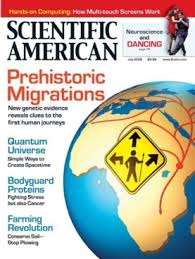Did human really originate from Africa: New take
Friday, April 25th, 2014 6:59:59 by Mike Ross
An analysis of genetic diversity and cranial measurements of 10 African and Asian populations indicates that humans dispersed out of Africa into two batches and the first one was much earlier than previously thought. The second migration that scattered human of northern Eurasia 50,000 years ago, comes to correspond with what was known until now as the only way out of África. Pero, the study of the University of Tübingen, was preceded by a much earlier migration, which began 130,000 years ago, and the current coming Australian Aboriginal and Papua New Guinea and the islands of Melanesia.
The simple idea that humanity living outside Africa comes from a small population that left the continent 50,000 years ago is undergoing significant revisions. First because of archaeological finds have revealed the presence of humans in Arabia and the Middle East before that date. And second, by comparisons of the genomes of present populations around the world, reveal a far more complicated picture than previously thought. And not just for the crossings of modern humans with Neanderthals and Denisovans.
The current consensus is that our species, Homo sapiens originated in Africa 100,000 to 200,000 years ago as paleontological and genetic data, but later spread to Africa and the rest of the world is controversial. “Our results support an initial spread eastward through southern Asia that began as early as 130,000 years ago, and a back to northern Eurasia 50,000 years ago,” says the director of research, Katerina Harvati Center Senckenberg of Human Evolution at the University of Tubingen. Presents the PNAS study with colleagues from the University of Ferrara and the National Museum of Natural History in Paris.
Harvati and colleagues have studied multiple individuals (10 to 215) of populations essential to discriminate between alternative models of dispersal of modern humans: Native inhabitants of Australia (Aboriginal), Central Asia, East Africa, Japan, Melanesia, north Philippine negritos (Aeta/Agta), New Guinea, northern and southern India and South Africa.
We hypothesized that double migration was proposed years ago, but in a very different way. According to the old idea, the first dispersion have happened shortly before the second, and have left their genetic mark on the current inhabitants of Australia, Melanesia, Papua New Guinea, speakers of Dravidian languages of South Asia and the Aeta/Agta (Negrito) in the Philippines.
The new results speak of a first ancient migration, and has only left footprints on genetic and morphological Australian Aboriginal and Melanesian. The black, or people of short stature, dark skin and curly hair in Southeast Asia, like the rest of the native inhabitants of South Asia, belong to the second migration, or mixed with it so they have lost their ancestral genetic markers.
“Our results” write Harvati and colleagues “are consistent generally with the view that current Australian Aborigines descended from a lineage that has remained relatively isolated from the middle Pleistocene”, ie from about 130,000 years ago. That does not mean that the original colonization of Australia occurred at that time remote – it looks like it dates from about 50,000 to 60,000 years ago, but the output of Africa that lineage was much earlier. The straightforward interpretation of this data is that it took 80,000 years to reach the Australian continent.
The new findings may explain some puzzling paradoxes that were with the previous scheme. For example, if there was only one migration out of Africa, how archaeological evidence of occupation by modern humans in the Arabian Peninsula, dating from 125,000 years ago to be explained? It is true that this evidence does not yet include any human fossil, but artifacts closely resembling found in Ethiopia, which are classified as modern, dating from about 150,000 years ago stone. The original migration of modern humans out of Africa, however, block exceptionally well with this misplaced data. Similarly, fits well with recent interpretations of early climate on the continent, that speak of a devastating drought that began to ravage East Africa just 135,000 years ago, again in an almost perfect temporal correspondence with the new data of Harvati and colleagues.
And of course, the existence of a migration 130,000 years ago makes it unnecessary to find an explanation for another paradox: the very long millennia that were supposed to have elapsed between the origin of the modern human species and its Output Africa. For all we know now, it is perfectly possible that our ancestors emigrated from mainland mother one day after its creation by the ever amazing and often enigmatic mechanisms of evolution, the real makers of all that exists in the biology of planet Earth.
Short URL: https://www.newspakistan.pk/?p=43317

















